Abstract
This paper deals with the issues of the impact of vertical vibrations on a child seated in a child seat during a journey. Its purpose was to assess the impact of fastening the child seats and road conditions on the level of vibrations recorded on child seats. The paper describes the tested child seats, the methodology of the tests and the test apparatus included in the measuring track. The tests were carried out in real road conditions where the child seats were located on the rear seat of a passenger vehicle. One was attached with standard seat belts, and the other with the ISOFIX base. When driving on roads with three types of surface, the following vertical accelerations were measured: seat of the child seats, the rear seat of the vehicle and the ISOfix base. The recorded accelerations were first analyzed in the time domain and then in the frequency domain. Three indexes (r.m.s, rmq and VDV) were used to assess the vibration comfort. Research has shown that the classic method of fastening a child seat with standard seat belts is more advantageous in terms of vibration comfort. Calculated indicators confirmed the negative impact of separating the child seat from the rear seat of the vehicle using the IQ ISOFIX base.
1. Introduction
In Poland and in other European Union countries, transporting children in child seats is obligatory. The main task of child seats is to ensure the child’s safety and reduce any possible injuries that may occur during a collision or road accident [1,2,3,4,5,6,7,8]. There are many design solutions for child seats on the market, which differ in terms of the fastening system, construction material and safety level, and selecting the ideal seat is a difficult task for buyers [9,10,11,12,13,14]. Immediately after buying the child seat, there is a problem with its installation in the vehicle. It is estimated that in Poland and Union European approximately 70% of child seats are installed incorrectly [15,16,17]. The most common mistakes when mounting the seat in the vehicle include choosing the wrong place for its installation, loose mounting, an incorrectly adjusted headrest, and incorrectly defined seat angle [16,17,18]. An improperly selected and, in addition, a badly installed child seat, instead of protecting the child against the effects of collisions and road accidents, may be an additional risk for the child [19,20,21]. The first child seats were constructed at the turn of the 1920s and 1930s [22]. Initially, their main task was to keep the child in a specific place, and not to ensure adequate safety [23,24]. Gradually, the development of child seats was equated with the knowledge concerning the behavior of the human body during road accidents. A breakthrough in the design of child seats occurred in 1966, when Bertil Aldman, a Doctor of Medical Sciences, published a research paper in which he pointed to the advantages of rear-facing child seats mounted on the front seat [4,22,25]. A year later, they were put on sale. Moreover, for the first time, they were also equipped with safety belts intended for children [22,23,25].
Increasingly, sensors are installed in child seats, which check the correctness of their fastening [25,26,27]. The child seats available on the market have many technical solutions, the main purpose of which is to increase the safety level of children while traveling. These solutions include [5,7]:
- ISOFIX—mounting system,
- a stabilizing leg,
- top fastening belt,
- side protection system,
- five-point seat belts.
Designers of child seats pay special attention to the comfort of children when travelling [25,26,27]. Manufactured child seats equipped with temperature sensors already exist, which provide information about whether the temperature in the vehicle is appropriate for the child being transported. The child seat prototype proposed by Mercedes-Benz and Britax Römer has a child behavior monitoring system. It records, among other things, a child’s body temperature, the number of breaths, as well as whether the child is sleeping or not. This information is provided to the child’s caregiver and thus reduces the possibility of distraction posed by constantly looking at the transported child. The introduction of new technologies to the production of child seats have been motivated by the necessity to look for solutions that may increase mobility and reduce driver distraction while driving [5,28,29].
UNECE Regulation No. 44 includes the division of child seats according to their body weight [30,31,32]:
- group 0 (0+)—child seats for children mass to 10 kg (13 kg),
- group I—child seats for children mass from 9 kg to 18 kg,
- group II—child seats for children mass from 15 kg to 25 kg,
- group III—child seats for children mass from 22 kg to 36 kg.
The proper selection of a child seat is related not only to its age but also to its anthropometric dimensions, such as mass and height [33,34]. Considering only one of the above-mentioned sizes in the seat selection is insufficient. It is also worth paying attention to the possibility of adjusting the height of the backrest and the width of the seat. A child in a child seat should first feel comfortable and safe [18,35,36].
The subject of vibration comfort of adult motor vehicle users, as opposed to the issue of the vibration comfort of children transported in child seats, has been quite thoroughly explored. The comfort felt by a child differs to a large extent from that of an adult [37,38,39,40,41]. In addition, an adult can correctly determine the degree of perceived comfort, while in the case of a small child it is impossible. The issues of vibrational comfort of adults have been discussed in many normative documents [42,43,44] The standards also describe the measures of the influence of vertical vibrations on a person in a sitting position There are no such standards for children in child seats [42,43,44,45,46,47]. The development of safety seats should go hand in hand with the development of vibration comfort [48,49,50]. The study in [51] presents the results of vibration tests carried out with the use of two child seats while driving on roads with different surfaces.
The results showed that the vibrations measured on the seat of the child seat turned out to be higher than the vibration level on the driver’s seat. Similar conclusions were presented in the study in [52]. The influence of wheel unbalance on the vibration comfort of children was discussed in [53]. The result of the ergonomic comfort tests, during which the distribution of pressure of the child’s body on the seat and backrest of child seats was analyzed, was a product-design assessment model (PDE) that facilitates the selection of materials and the angle of the backrest for manufacturers of child seats [54]. The result of this research is a model that makes it easier for child seat manufacturers to choose materials and tilt the backrests [51,52,53]. When reviewing the literature, it should be noted that child seats are mainly tested in terms of safety. Vibration comfort issues are unfortunately overlooked.
Importantly, it should be noted that despite the importance of the vibration comfort of child seats, it is neglected, and there are no child seats on the market that are equipped with acceleration sensors, which would allow the assessment of vibration comfort. However, child seats currently available on the market are becoming more and more advanced. Vehicle seats with sensors informing whether the child has properly fastened seat belts now exists, as well as an ISOFIX base with a sensor that provides information about the correct fastening of the seat [50,51,52,53,54]. It should be noted, however, that there are solutions for child seats, which are additionally equipped with a temperature sensor and sensors that allow for blood pressure measurements [55,56,57,58,59,60], Equipping safety seats with various types of sensors increases ergonomic comfort and improves safety.
2. Research Methodology
The aim of the experiment was to analyze the impact of road conditions, the child’s mass, and the method of mounting child seats on the vibration comfort of the children transported in it. The research was carried out on three sections of roads with the following surfaces: asphalt, gravel, and paving. A passenger vehicle of a lower-middle class was used in the research. To limit the influence of the technical condition of the test car on the measurement results, the vehicle was subjected to additional technical tests before the initiation of the tests. When inspecting and assessing the technical condition of the vehicle, particular attention was paid to the suspension and running gear. Among other things, the technical condition of the shock absorbers was reviewed, as well as the correctness of wheel balancing and the air pressure in the tires. During the experiment, the air pressure in the tires was 0.25 MPa in the front axle wheels and 0.2 MPa in the rear axle wheels, respectively. The wheels were balanced with an accuracy of 2 g.
During the tests, two child seats were attached to the rear seat of the test vehicle. For one of them, an Avionaut Pixel was attached in the standard way with the vehicles seat belts, while for the other an Avionaut AeroFIX was fastened with the ISOFIX system.
Three series of studies were conducted. Within each of them, three vehicle rides with mounted child seats were conducted. During each of the journeys, the child seats were loaded with a different mass imitating the mass of a child of 5 kg, 10 kg, and 15 kg, respectively. The speed of the vehicle during each trip was maintained at a constant level of 50 km/h.
3. Research Object
The following two seats were used in the experiment: Avionaut Pixel (Figure 1) and Avionaut AeroFIX (Figure 2). The technical specifications of the child seats are presented in Table 1.
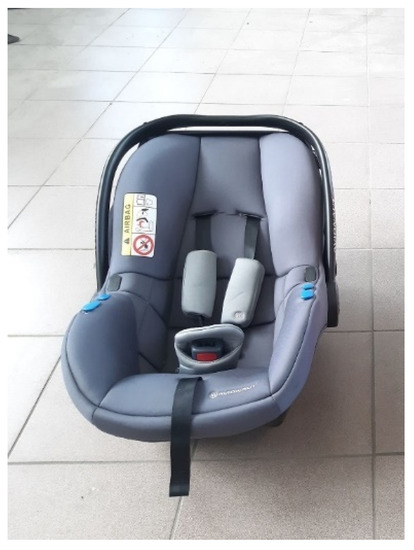
Figure 1.
Avionaut Pixel child seat.
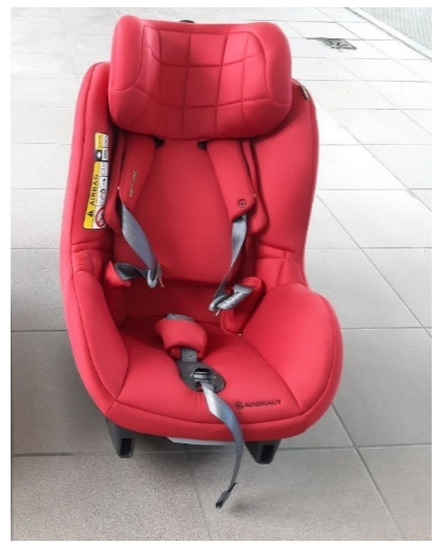
Figure 2.
Avionaut AeroFIX child seat.

Table 1.
Parameters of the tested child seats [61].
The Avionaut Pixel child seat is designed to transport children mass up to 13 kg and a height from 0.45 m to 0.86 m. Its curb mass is 2.5 kg. It is made of a composite material with an EPP ARPRO designation, which does not deform during impact, but due to its flexibility it absorbs energy, distributing it evenly throughout its structure [61].
The Avionaut AeroFIX seat is designed to transport children with a height of 0.67 m to 1.05 m and a mass of up to 17.5 kg. It has been designed in such a way that it is possible to transport a child in a rearward-facing position, if their height does not exceed 1.05 m. Its curb weight is 4 kg. The child seat has a side protection system that protects the child in side impacts. The child seat was attached to a dedicated device, called the ISOFIX base. It allows for the seat to be mounted in the vehicle both forward and rearward facing. In vehicles not equipped with this type of system, both child seats can be fastened with the seat belts [61].
4. Research Apparatus
During the experiment, the longitudinal speed of the vehicle was controlled by a measuring system consisting of an optoelectronic sensor of longitudinal and lateral speed (Correvit S-350), a data acquisition system and computer. The sensor was attached to the body of the test vehicle by means of a holder, which allowed for the adjustment of the position of the sensor in relation to the road surface. The built-in measuring system registered the speed in the range from 0.5 km/h to 250 km/h, and this signal can be updated with a frequency of up to 250 Hz.
In the research, the acceleration of rear seats was measured with ISOfix bases, Avionaut Pixel seats, and Avionaut AeroFIX seats. The accelerations were recorded using a measurement track (Figure 3) consisting of four three-way acceleration sensors (Table 2), a digital LMS SCADAS Recorder model SCR02 and a measuring computer. The frequency of recording the acceleration signals was 1024 Hz. The measuring line was powered by a 12 V battery with the use of a converter.

Figure 3.
Diagram of the measurement path.

Table 2.
Technical parameters of acceleration sensors.
Places showing the mounting points of the acceleration sensors are shown in Figure 4, Figure 5 and Figure 6, and the method of their mounting is shown in Figure 7.

Figure 4.
Mounting the acceleration sensor on the Isofix base.
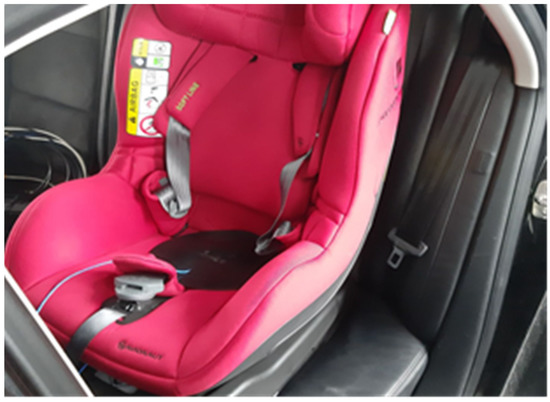
Figure 5.
Fastening the acceleration sensor to the child seat.
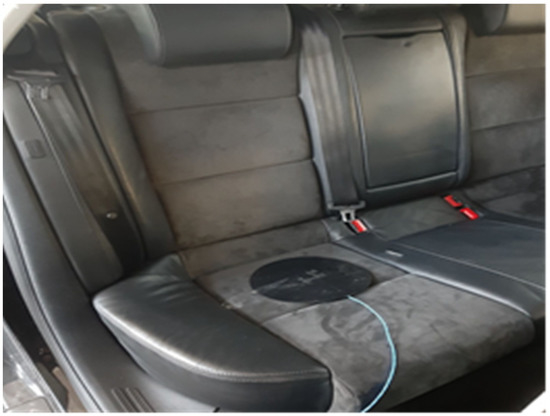
Figure 6.
Fixing the acceleration sensor to the rear seat.
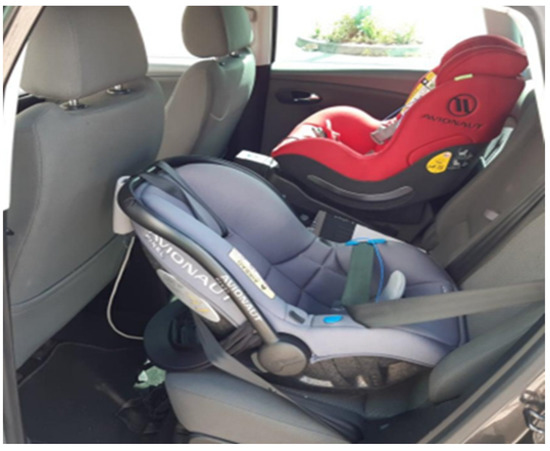
Figure 7.
Fixing child seats in a passenger vehicle.
5. Road Test Results and Their Analysis
The results of the measurements were used to determine the time courses of vertical accelerations and indicators for the assessment of vibration comfort. Examples of waveforms of vibrations recorded on the seats of the tested child seats are shown in Figure 8, Figure 9 and Figure 10. The recorded courses of acceleration for the seat of the AvionautPixel child seat and the seat of the AvionautAeroFIX child seat are similar in terms of quality. However, there are quantitative differences between them. In each of the analyzed journeys, higher acceleration values were recorded on the seat of the Avionaut AeroFIX child seat.
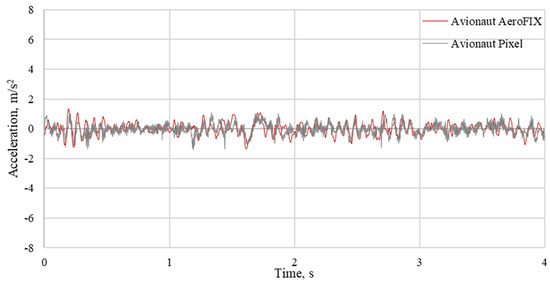
Figure 8.
The vertical accelerations recorded on the seat of child seats loaded with a mass of 10 kg driving on an asphalt road.
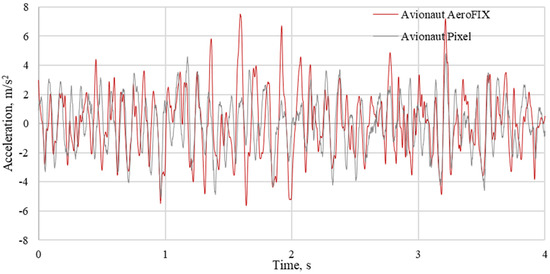
Figure 9.
Vertical accelerations recorded on the seat of child seats loaded with a mass of 10 kg when driving on a gravel road.
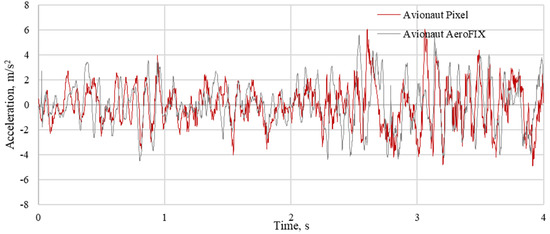
Figure 10.
The vertical accelerations recorded on the seat of the child seats weighed 10 kg when driving on a cobblestone road.
Considering the fact that vibrations are quite a complex phenomenon, it is impossible to analyze them comprehensively using only one measure. With the directly measured vibration accelerations, comfort indicators were used to assess their impact on the vibration comfort. These indicators describe the ISO 2631-1 and BS 6841 standards. Depending on the acceleration value m.s, ISO 2631-1: 1997 specifies the level of comfort on a six-point scale. The same discomfort scale with regard to rmq is found in BS 6841. In this analysis, the authors decided to use the following three measures:
- Root mean square (rms)
- Vibration Dose Value (VDV)
- Root mean quad (rmq)
where:
- a (t)—vertical acceleration value, m/s2, recorded as a function of time t
- T—segment of the measurement duration, s.
Table 3 presents the summary of the values of the determined indicators of the vibration comfort assessment rms, VDV and rmq for the measurements carried out with the child seats loaded with a mass of 5 kg, 10 kg, and 15 kg.

Table 3.
The values of vibration comfort indicators.
The results of the assessment of vibration comfort, according to the VDV index for the tested seats, are presented in Figure 11, Figure 12 and Figure 13.
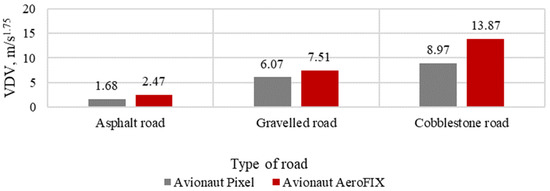
Figure 11.
VDV indicator with a child seat load of 5 kg.
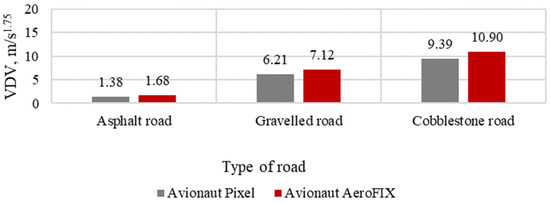
Figure 12.
VDV indicator with a child seat load of 10 kg.
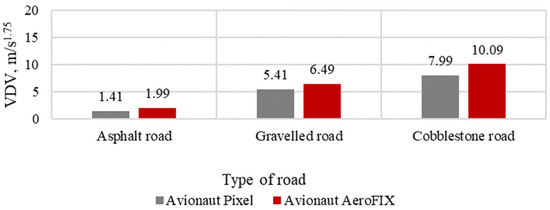
Figure 13.
VDV indicator with a child seat load of 15 kg.
The correct fastening of the child seat and the materials from which the child seats are made are important to dampen vibrations that penetrate from the road surface to the child seat. In the next stage of the analysis, each of the recorded signals was subjected to a discrete Fourier transformation and then the amplitude-frequency characteristics were determined. Their examples are shown in Figure 14 and Figure 15.
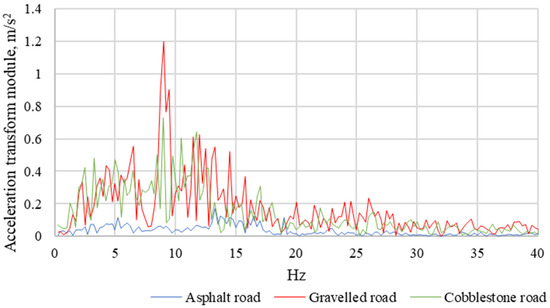
Figure 14.
Amplitude-frequency characteristics of the seat of the Avionaut AeroFIX child seat with a mass of 10 kg.
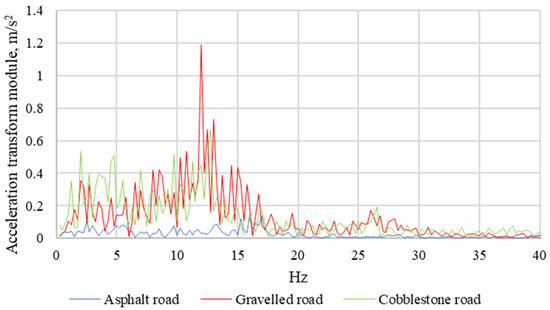
Figure 15.
Amplitude-frequency characteristics of the seat of the Avionaut Pixel child seat with a mass of 10 kg.
6. Analysis of the Results
The analysis of the rms values of accelerations listed in Table 3 shows that the accelerations recorded on the child seat fastened with seat belts are lower than the accelerations recorded on the seat fastened with the IQISOFIX base. The type of road surface on which the tests were carried out had a significant impact on the level of acceleration, apart from the method of mounting and the mass loading the seat.
The lowest acceleration values were recorded for the seats of the child seats during journeys made on an asphalt road. The RMS values for these accelerations for the Avionaut Pixel child seat range from 0.34 m/s2 to 0.4 m/s2. They are lower than the effective rms values of acceleration recorded on the Avionaut AeroFIX child seat, which are in the range from 0.39 m/s2 to 0.62 m/s2.
The highest accelerations were recorded while driving on the paved surface on the seat of the child seat. The effective rms values for these accelerations for the Avionaut Pixel child seat range from 2.18 m/s2 to 2.58 m/s2. They are lower than the effective rms values of acceleration recorded on the Avionaut AeroFIX child seat, which are in a range from 2.69 m/s2 to 3.56 m/s2.
Relating the determined effective values of rms accelerations to the limits of discomfort of adults, it should be stated that: Transporting children in the Avionaut Pixel child seat on the asphalt and gravel road may cause them slight discomfort, while on the paved road, the child may feel very or extremely uncomfortable. Transporting children in the Avionaut AeroFIX child seat on an asphalt road and in one case (when its mass is 15 kg) on a gravel surface may cause them a feeling of slight discomfort. In other cases, the child transported in this child seat may feel very or extremely uncomfortable.
The rqm indicator provides a greater share in the assessment of accelerations with higher amplitudes, due to the fourth power of accelerations. It is more sensitive to acceleration pulses. This effect can be observed by comparing the values of the rms and rqm indicators, determined for the acceleration curves recorded during runs on the asphalt road with the rms and rqm indicators determined for the acceleration curves recorded during the runs on gravel and paved roads. The highest values of the rmq index were recorded for the runs on the gravel surface. This is due, inter alia, to the fact that the surface was covered with numerous irregularities.
For the determined amplitude-frequency, characteristics bands of local maxima were observed. The acceleration amplitudes are the highest when driving on a gravel road. Being in the range from 5 Hz to 15 Hz, they are ten times higher than the acceleration amplitudes recorded during asphalt road journeys and over 35 percent higher than the acceleration amplitudes recorded during paved-road journeys.
7. Conclusions
For a child seat to be approved for sale, it must pass a series of safety tests. Currently, seats that meet the requirements of ECE R44 and UN R129 are approved for sale. It should be noted, however, that child seats approved for sale are not tested in terms of comfort. Unfortunately, the omission of such an important factor in the production of child seats results in vibrations generated by road unevenness being largely transferred to the seat of the child seat. Such a situation may cause that the child transported in a child seat to not feel comfortable during the journey.
The analysis of the values of the determined indicators showed that the type of road surface on which the tests were carried out had a decisive influence on the level of acceleration recorded on the seats of child seats. Driving on a gravel road turned out to be less comfortable than driving on an asphalt road. The least comfortable drive was the cobblestone road.
The effective rms acceleration values determined for the tested vehicle seats are higher than the adult comfort limit, which is 0.315 m/s2. This limit applies to adults, as mentioned, and it is difficult to determine the feelings of children.
The leg stabilization of the IQ ISOFIX base transmits the vibrations to the seat directly from the floor. Consequently, it contributes to the deterioration of the vibration comfort of children carried in the seat. The negative impact of separating the child seat from the rear seat of the vehicle using the IQ ISOFIX base is confirmed by the calculated indicators (rms, rmq and VDV). For the child seat fastened in a classic way, the values of these indicators were significantly lower than the values of the indicators determined for the seat fastened with the ISOFIX system.
There are no standards for carrying out tests on the vibration comfort of children. To better identify the issue of the propagation of vibrations in the child seat system it is desirable to conduct tests concerning more seats. Further research is necessary due to the need to develop standards for carrying out tests and assessing the vibration comfort of children. Additionally, guidelines should also be drawn up regarding the maximum length of time a child can be seated in the seat without negative consequences for their health.
Therefore, in the future, the child’s seat should be considered in addition to the standard sensors of puncture, blood pressure sensors or sensors of the correct fastening of the seat, and they should be equipped with an acceleration sensor that determines the level of vibrations from the road surface to the seat of the child’s seat. In order to reduce the level of acceleration recorded on child seats, the ISOfix base should be expanded with a damping element, with the task of dampening the transmitted vibrations.
This study, concerning the vibration comfort of children, should not discourage parents from transporting their children in vehicle seats, as they are the most effective product protecting children against injuries and deaths during road accidents.
Author Contributions
Conceptualization: A.Z. and D.F.; methodology: A.Z., D.F. and M.Ż.; software; M.Ż. and J.J.; validation; A.Z. and D.F.; formal analysis: A.Z., J.J. and D.F.; investigation; A.Z., D.F. and J.J.; resources; A.Z. and D.F.; data curation; A.Z. and J.J.; writing—original draft preparation; A.Z. and D.F.; writing—review and editing; A.Z. and D.F.; visualization; A.Z. and D.F.; supervision; A.Z. and D.F.; project administration: A.Z. and D.F. All authors have read and agreed to the published version of the manuscript.
Funding
This research received no external funding.
Institutional Review Board Statement
Not applicable.
Informed Consent Statement
Not applicable.
Data Availability Statement
Not applicable.
Conflicts of Interest
The authors declare no conflict of interest.
References
- Brown, S.H.M.; Grondin, D.E.; Potvin, J.R. Strength Limitations to Proper Child Safety Seat Installation: Implications for Child Safety. Appl. Ergon. 2009, 40, 617–621. [Google Scholar] [CrossRef] [PubMed]
- Uddin, A.; Kulanthayan, K.C.M.; Tanveer, K.A. Child Restraint System: Lessons Learned from Global Best Practices. Int. J. Acad. Res. Bus. Soc. Sci. 2021, 11, 904–921. [Google Scholar] [CrossRef]
- Wen, Y.; Yang, W. Application of Ergonomics Form in Car Seat Modeling Design. In Proceedings of the 2nd International Conference on Artificial Intelligence and Advanced Manufacture (AIAM2020), Manchester, UK, 15–17 October 2020; Association for Computing Machinery: New York, NY, USA, 2020; pp. 326–329. [Google Scholar] [CrossRef]
- Seat Car History. Available online: https://8stars.com/pl/module/smartblog/details?id_post=5 (accessed on 14 October 2021).
- Brown, J.; Finch, C.F.; Hatfield, J.; Bilston, L.E. Child Restraint Fitting Stations reduce incorrect restraint use among child occupants. Accid. Anal. Prev. 2011, 43, 1128–1133. [Google Scholar] [CrossRef]
- Frej, D.; Grabski, P.; Szumska, E. Analysis of the Causes of Vehicle Accidents in Poland in 2009–2019. LOGI—Sci. J. Transp. Logist. 2020, 11, 76–87. [Google Scholar] [CrossRef]
- Moravčík, E.; Jaśkiewicz, M. Boosting car safety in the EU. In Proceedings of the 2018 XI International Science-Technical Conference Automotive Safety, Žastá, Slovakia, 18–20 April 2018; pp. 1–5. [Google Scholar] [CrossRef]
- Jurecki, R.; Jaśkiewicz, M. Analysis of Road accidents over the last ten years. Zesz. Nauk. Akad. Mor. W Szczec. 2012, 32, 65–70. [Google Scholar]
- Berger, M.; Dandekar, A.; Bernhaupt, R.; Pfleging, B. An AR-Enabled Interactive Car Door to Extend In-Car Infotainment Systems for Rear Seat Passengers. In Proceedings of the Extended Abstracts of the 2021 CHI Conference on Human Factors in Computing Systems, Yokohama, Japan, 8–13 May 2021; Association for Computing Machinery: New York, NY, USA, 2021; Volume 404, pp. 1–6. [Google Scholar] [CrossRef]
- Greenspa, A.; Dellinger, A.; Chen, J. Restraint use and seating position among children less than 13 years of age: Is it still a problem? J. Saf. Res. 2010, 41, 83–185. [Google Scholar]
- Lee, S.K.; White, P.R. Application of wavelet analysis to the impact harshness of a vehicle. Proc. Inst. Mech. Eng. Part C J. Mech. Eng. Sci. 2000, 214, 1331–1338. [Google Scholar] [CrossRef]
- Lesire, P.; Johannsen, H.; Willinger, R.; Longto, A. CASPER—Improvement of child safety in cars. Procedia Soc. Behav. Sci. 2012, 48, 2654–2663. [Google Scholar] [CrossRef][Green Version]
- Lee, G.; Pope, C.N.; Nwosu, A.; McKenzie, L.B.; Zhu, M. Child passenger fatality: Child restraint system usage and contributing factors among the youngest passengers from 2011 to 2015. J. Saf. Res. 2019, 70, 33–38. [Google Scholar] [CrossRef]
- Stokłosa, J.; Jaśkiewicz, M. Simulation study of longitudinal forces in the coupling device of heavy freight trains. Adv. Sci. Technol. Res. J. 2014, 8, 24–30. [Google Scholar] [CrossRef]
- Hayes, M. Child safety in cars. BMJ 2007, 333, 1183–1184. [Google Scholar] [CrossRef]
- Snowdon, A.W.; Polgar, J.; Linda, P.; Lynnette, S. Parents’ knowledge about and use of child safety systems. Can. J. Nurs. Res. 2006, 38, 98–114. [Google Scholar] [PubMed]
- Biagioli, F. Educating Oregon Families about Child Safety Seats. Calif. J. Health Promot. 2004, 2, 55–58. [Google Scholar] [CrossRef]
- Sergio, O.; Claudio, L.; Carvalho, M.; Rosangela, S.; Lüders, L.; Fernanda, O. Child safety seat usage errors in under-4s. J. De Pediatr. 2012, 88, 297–302. [Google Scholar] [CrossRef]
- Vicki, A.Z.; Santis, J.P. Booster Seat or Seat Belt? Motor Vehicle Injuries and Child Restraint Laws in Preschool and Early School-Age Children. J. Spec. Pediatric Nurs. 2005, 10, 183–190. [Google Scholar]
- Jadhav, T.A.; Thakare, G.S. Design and Analysis of Bus Passenger Seat as PerAIS-023. Int. J. Eng. Res. Technol. 2019, 8, 458–462. [Google Scholar]
- Baranowski, P.; Damaziak, K.; Malachowski, J.; Mazurkiewicz, L.; Muszyński, A. A Child Seat Numerical Model Validation in the Static and Dynamic Work Conditions. Arch. Civ. Mech. Eng. 2015, 15, 361–375. [Google Scholar] [CrossRef]
- The History of Children’s Car Seats. Available online: https://www.titlemax.com/articles/the-history-of-childrens-car-seats/ (accessed on 14 October 2021).
- Child Safety in Cars a Guide to Driving Safely with Children on Board. Available online: https://www.rsa.ie/Documents/Road%20Safety/Safety%20for%20kids/Child%20Safety%20in%20Cars%20English.pdf (accessed on 14 October 2021).
- Song, Y.J.; Jeon, E.S. Lightweight Design of Child Pop-up Seat Leg Part Based on Dynamic Environment. Int. J. Mech. Eng. Technol. 2019, 10, 527–537. [Google Scholar]
- Blair, J.; Perdios, A.; Babul, S.; Young, K.; Beckles, J.; Pike, I.; Cripton, P.; Sasges, D.; Mulpuri, K.; Desapriya, E. The appropriate and inappropriate use of child restraint seats in Manitoba. Int. J. Inj. Contr. Saf. Promot. 2008, 15, 151–156. [Google Scholar] [CrossRef]
- Seng, W.F.; Bin, L. Intelligent gestural control and ergonomic analysis in barrier-free car seat design. In Proceedings of the 3rd International Conference on Industrial and Business Engineering (ICIBE 2017), Sapporo, Japan, 17–19 August 2017; Association for Computing Machinery: New York, NY, USA, 2017; pp. 34–39. [Google Scholar] [CrossRef]
- Triawan, F.; Prayogo, M.A.; Rochmad, C.O.; Simarmata, A. Structural Design and Strength Analysis of Motorcycle Child Seat. In Proceedings of the 2020 6th International Conference on Computing Engineering and Design (ICCED), Sukabumi, Indonesia, 15–16 October 2020; pp. 1–6. [Google Scholar] [CrossRef]
- Posuniak, P.; Jaśkiewicz, M.; Kowalski, K.; Dąbrowski, F. Child restraint systems: Problems related to the safety of children transported in booster seats (without integral safety belts). In Proceedings of the 2018 XI International Science-Technical Conference Automotive Safety, Casta, Slovakia, 18–20 April 2018; pp. 1–7. [Google Scholar] [CrossRef]
- Cicchino, J.B.; Jermakian, J.S. Vehicle characteristics associated with LATCH use and correct use in real-world child restraint installations. J. Saf. Res. 2015, 53, 77–85. [Google Scholar] [CrossRef]
- Frej, D.P.; Podosek, K.; To, K. Overview of design solutions for child seats. Arch. Automot. Eng. Arch. Motoryz. 2021, 92, 33–47. [Google Scholar]
- Togashi, N.; Shimono, T.; Nozaki, T.; Shibata, T.; Aoyama, Y.; Kitahashi, Y. Development of Three-Axis Seating Posture Holding Assist Chair and Proposed Variable Compliance Control. In Proceedings of the 2019 IEEE International Conference on Mechatronics (ICM), Ilmenau, Germany, 18–20 March 2019; pp. 455–460. [Google Scholar] [CrossRef]
- Więckowski, D. An attempt to estimate natural frequencies of parts of the child’s body (Próba oszacowania częstotliwości drgań własnych części ciała dziecka). Arch. Automot. Eng. Arch. Motoryz. 2012, 55, 61–74. [Google Scholar]
- Balci, B.; Alkan, B.; Elihos, A.; Artan, Y. Front Seat Child Occupancy Detection Using Road Surveillance Camera Images. In Proceedings of the 25th IEEE International Conference on Image Processing (ICIP), Athens, Greece, 7–10 October 2018; pp. 1927–1931. [Google Scholar] [CrossRef]
- Zhu, H.; Zhang, Y. Analysis on the design of child safety seats in vehicle. In Proceedings of the 2008 9th International Conference on Computer-Aided Industrial Design and Conceptual Design, Kunming, China, 22–25 November 2008; pp. 214–217. [Google Scholar] [CrossRef]
- Muszyński, A.; Trzaska, P.; Wicher, J. Analysis of the forces developing in the straps of the belts that restrain a child in a safety seat (Analiza sił działających w taśmach pasów podtrzymujących dziecko w foteliku bezpieczeństwa). Arch. Automot. Eng. Arch. Motoryz. 2015, 67, 113–126. [Google Scholar]
- Sen, G.; Sener-Pedgley, B. Design for Luxury Front-Seat Passenger Infotainment Systems with Experience Prototyping through VR. Int. J. Hum.-Comput. Interact. 2020, 36, 1714–1733. [Google Scholar] [CrossRef]
- Więckowski, D. Analysis domain of the time vertical vibration on account comfort child during ride in the vehicle (Analiza w dziedzinie czasu drgań pionowych ze względu na comfort podróżowania dziecka w samochodzie). Czas. Tech. Mech. 2012, 109, 73–91. [Google Scholar]
- Zuska, A.; Szumska, E.; Frej, D. Laboratory Tests of the Control of the Child Seats using Method for the Vibration Comfort of Children Transported in Them. Commun. Sci. Lett. Univ. Zilina 2021, 23, B187–B199. [Google Scholar] [CrossRef]
- Zuska, A.; Szumska, E.; Frej, D. Laboratory studies of the influence of the working position of the passenger vehicle air suspension on the vibration comfort of children transported in the child restraint system. Open Eng. 2021, 11, 470–482. [Google Scholar] [CrossRef]
- Dižo, J.; Blatnický, M.; Melnik, R. Assessment of the Passenger Ride Comfort for a Coach by Means of Simulation Computations. LOGI—Sci. J. Transp. Logist. 2017, 8, 24–32. [Google Scholar] [CrossRef]
- Cvok, I.; Hrgetić, M.; Hoić, M.; Deur, J.; Ivanovic, V. Design of a linear motor-based shaker rig for testing driver’s perceived ride comfort. Mechatronics 2021, 75, 102521. [Google Scholar] [CrossRef]
- ISO 2631-4:2001. Mechanical Vibration and Shock—Evaluation of Human Exposure to Whole-Body Vibration—Part 4: Guidelines for the Evaluation of the Effects of Vibration and Rotational Motion on Passenger and Crew Comfort in Fixed-Guideway Transport Systems; ISO: Geneva, Switzerland, 2001. [Google Scholar]
- ISO 2631-5:2018. Mechanical Vibration and Shock—Evaluation of Human Exposure to Whole-Body Vibration—Part 5: Method for Evaluation of Vibration Containing Multiple Shocks; ISO: Geneva, Switzerland, 2018. [Google Scholar]
- PN-EN ISO 5349-1:2004. Drgania Mechaniczne—Pomiar i Wyznaczanie Ekspozycji Człowieka na Drgania Przenoszone Przez Kończyny Górne—Część 1: Wymagania Ogólne (Mechanical Vibration—Measurement and Determination of Human Exposure to Hand-Arm Vibration—Part 1: General Requirements); ISO: Geneva, Switzerland, 2004. [Google Scholar]
- BS 6841. 1987 Guide to Measurement and Evaluation of Human Exposure to Whole-Bodymechanical Vibration and Repeated Shocks; BSI: London, UK, 1987. [Google Scholar]
- PN-91 N-01354. Drgania—Dopuszczalne Wartości Przyspieszenia Drgań o Ogólnym Oddziaływaniu na Organizm Człowieka i Metody Oceny Narażenia, (Vibrations. Permissible Values of Vibration Acceleration with General Impact on the Human Body and Methods of Exposure Assessment). Available online: http://www.diagnostyka.net.pl/DIAGNOSTYKA-30-t-I-2004,81323,0,2.html (accessed on 1 December 2021).
- PN-91 S-04100. Drgania—Metody Badań i Oceny Drgań Mechanicznych na Stanowiskach Pracy w Pojazdach (Vibrations. Methods of Research and Evaluation of Mechanical Vibrations at Work Stations in Vehicles). Available online: https://www.google.com.hk/url?sa=t&rct=j&q=&esrc=s&source=web&cd=&ved=2ahUKEwiIx8TvzdX0AhU3s1YBHStkDaUQFnoECBEQAQ&url=https%3A%2F%2Fwww.wt.pw.edu.pl%2Fcontent%2Fdownload%2F6314%2F35474%2Ffile%2FEwa%2520Kardas-Cinal.pdf&usg=AOvVaw3LVyck1zo9cUhj8WdZAPfI (accessed on 1 December 2021).
- Changshuai, Y.; Haitao, L.; Siwei, G. Vibration Test and Vibration Reduction Design of UAV Load Radar. In Proceedings of the 2019 4th International Conference on Automation, Control and Robotics Engineering (CACRE2019), Shenzhen, China, 19–21 July 2019; Association for Computing Machinery: New York, NY, USA, 2019; Volume 70, pp. 1–6. [Google Scholar] [CrossRef]
- Zuska, A.; Szumska, E.; Frej, D. Analysis of the Impact of a Child Seat Mounting Method on Vertical Vibrations Affecting a Child in a Child Seat. In Proceedings of the 2020 XII International Science-Technical Conference Automotive Safety, Kielce, Poland, 21–23 October 2020; pp. 1–8. [Google Scholar] [CrossRef]
- Frej, D.; Zuska, A.; Cadge, K. Analysis of vertical vibrations affecting a child transported in a child seat during a car passing over the release speed bump. Arch. Automot. Eng. Arch. Motoryz. 2019, 86, 111–125. [Google Scholar] [CrossRef]
- Giacomin, J. Some observations regarding the vibrational environment in child safety seats. Appl. Ergon. 2000, 31, 207–215. [Google Scholar] [CrossRef]
- Wicher, J.; Więckowski, D. Influence of vibrations of the child seat on the comfort of child’s ride in a car (Wpływ drgań fotelika samochodowego na comfort podróżowania dziecka w samochodzie). Eksploat. I Niezawodn. 2010, 4, 102–110. [Google Scholar]
- Frej, D.; Grabski, P. The impact of the unbalanced rear wheel on the vibrating comfort of the child seat. Transp. Res. Procedia 2019, 40, 678–685. [Google Scholar] [CrossRef]
- Lai, H.H.; Chen, C.H.; Chen, Y.C.; Yeh, J.W.; Lai, C.F. Product design evaluation model of child car seat using gray relational analysis. Adv. Eng. Inform. 2009, 23, 165–173. [Google Scholar] [CrossRef]
- Caban, J. Study of eco-driving possibilities in passenger car used in urban traffic. Arch. Automot. Eng. Arch. Motoryz. 2021, 91, 37–48. [Google Scholar] [CrossRef]
- Smartbeat Car Seat Clip. Available online: https://engineering.usu.edu/ece/files/pdfs/senior-projects/fall2016-spring2017/smartbeat-car-seat-clip.pdf (accessed on 14 October 2021).
- Life-Saving Car Seat Alarms That Remind Parents There’s a Baby in the Back Seat. Available online: https://www.fatherly.com/gear/best-car-seat-alarms/ (accessed on 14 October 2021).
- Fojtlin, M.; Pokorny, J.; Fišer, J.; Toma, R.; Tuhovcak, J. Impact of measurable physical phenomena on contact thermal comfort. EPJ Web Conf. 2017, 143, 02026. [Google Scholar] [CrossRef]
- André, M.; De Vecchi, R.; Lamberts, R. User-centered environmental control: A review of current findings on personal conditioning systems and personal comfort models. Energy Build. 2020, 222, 110011. [Google Scholar] [CrossRef]
- Seniors’ Smart Car Seat Could Prevent Child Deaths. Available online: https://engineering.vanderbilt.edu/news/2013/seniors%E2%80%99-smart-car-seat-could-prevent-child-deaths/ (accessed on 14 October 2021).
- Vision Avionaut. Available online: https://avionaut.com/pl/ (accessed on 14 October 2021).
Publisher’s Note: MDPI stays neutral with regard to jurisdictional claims in published maps and institutional affiliations. |
© 2021 by the authors. Licensee MDPI, Basel, Switzerland. This article is an open access article distributed under the terms and conditions of the Creative Commons Attribution (CC BY) license (https://creativecommons.org/licenses/by/4.0/).